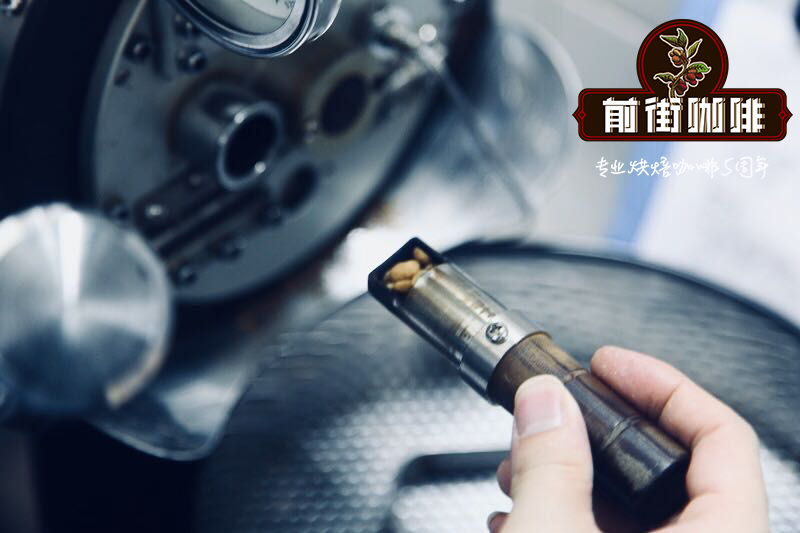The significance and differences of different baking degrees the characteristics of shallow baking, medium baking and deep baking
Shallow baking
Light roasted coffee is light brown, the surface does not have luster or grease, and the baking time is not long enough to develop more substances, this roasted bean surface is somewhat smooth and dark lines, baked to the initial point of time.
The name comes from the popping sound of coffee beans when roasted to about 205 degrees Celsius. When the temperature rises, the beans expand, and the temperature evaporates the water from the bean noodles, a process that creates pressure and forces the coffee beans to expand.
Light-roasted coffee usually has a fine acidity and retains more original flavor than deep-roasted coffee. Light roasted coffee is cleaner and brighter in acidity, with delicate floral or fruity aromas and a lighter mellow thickness. You can taste the natural characteristics of this coffee in the light roasted coffee.
However, although light-roasted coffee can show the original flavor of coffee, light-roasted coffee may be underbaked, resulting in underbaked flavor.
Light roasted coffee can be subdivided into several different names, the following are more common:
Shallow urban / semi-urban baking: a shallower baking degree than urban baking
Cinnamon roasting: the name comes from the color of the coffee bean rather than the aroma of the coffee bean itself or the addition of any spices
Gold roasting: because the above cinnamon roasting is often misleading, this term is often used by Starbucks to represent the color of roasted coffee.
New England: this baking name comes from the baking degree that is most popular with people in the northeastern United States.
Medium baking
As long as the baking time is lengthened, it will change from shallow baking to medium baking, but there will still be no oily bean surface, and the medium-baked bean surface will be smoother, bake to a burst and prolong the flavor development period.
At this stage of roasting, the coffee beans will have the precursor of a second explosion, the coffee will still retain the original flavor and acidity, and will produce a fuller taste because of the roasting. This roasted coffee has a balance between acidity and alcohol thickness.
Medium-roasted coffee has a balance in acidity, sweetness and alcohol thickness, and he says the increase in caramelization during roasting will transform fruit flavors into chocolate and nut flavors.
The lightly roasted coffee can show the natural flavor and sweetness of the coffee, and at the same time avoid the problem of underdevelopment of the flavor of the shallow roasted coffee.
Each roasted coffee has its own flavor characteristics, while the medium-roasted coffee is usually mellow and sweet.
Usually, roasted coffee has the following synonyms:
American baking: the name of a direct link to the United States
Baking after breakfast / dinner: both refer to medium baking, but the baking is slightly deeper after dinner.
City + baking: more flavor development time than city baking.
Baking in the whole city; the baking degree of medium and deep baking is close to the second explosion.
Deep baking
The colors of deep-roasted coffee range from brown to shiny black, and the deeper the coffee is roasted, the more greasy the surface is. The degree of roasting is after the second explosion, and the temperature of the beans has usually reached 230 degrees.
This roasted coffee bean will lose more water, so the bean density will be lower, and the original flavor of the bean will almost disappear because of the roasting, which means that the coffee will have lower flavor heterozygosity, low acidity and full taste.
Deep roasting only retains a small amount of the original flavor of coffee beans, so most of the flavor comes from roasting. Deep-roasted coffee has only a very small amount of acidity, with dark chocolate-like flavor and sweetness. This baking degree is easy to drink tobacco and bitterness.
The following is a synonym for deep-roasted coffee:
Vienna roasting: medium and deep roasted coffee, roasted until the middle of the second explosion, is very popular in Vienna, the capital of Austria.
New Orleans Bakery: the degree of deep baking that is usually preferred by local residents in American cities
French re-baking: this baking degree represents the complete end of the second explosion period.
Italian re-baking: a deeper baking degree than French re-baking.
Naples / Spanish baking: this type of baking is basically baked to the deepest extent.
Why there is no "best baking"
The degree of baking depends on individual taste preferences, which are very subjective and different, so there is no right or wrong baking, and the baking degree does have a wide range.
Coffee manufacturers usually prefer light-roasted coffee, but customers usually prefer deep-roasted coffee, and medium-roasted coffee beans sell best, followed by deep-roasted coffee, followed by shallow roasted beans.
Although there is no so-called optimal roasting degree, the reputation of very deep roasted coffee is not very good in the boutique coffee world, because the bitterness is more obvious and has a strong baking flavor. these roasted flavors will cover the flavor brought by the original producing area, variety, treatment, etc. However, this will also be affected by the grinding thickness, water temperature and other factors during coffee extraction.
We may all drink horrible coffee that is overbaked, charred and bitter, which is not a good flavor recognized by the boutique coffee industry, and we want to emphasize certain characteristics of roasted coffee, not to destroy these original flavors by roasting. And I see a shift taking place, where professionals are starting to appreciate deeper-roasted coffee, which has more stories to tell than roasted coffee at a shorter stage of development.

Why does medium roast coffee taste different?
Most roasting degrees have different flavors, but this does not mean that you will get the same flavor coffee with the same roasting degree. When determining the roasting degree of a coffee bean, it will take into account the producing country, producing area, planting altitude, variety, bean density, water activity, moisture content, treatment, and the temperature and humidity of the raw bean preservation environment.
These coffee planting conditions are strongly linked, such as variety, treatment, roasting degree, etc., different treatment methods will directly affect the chemical composition of raw beans, coffee seeds in fermentation, pressure, photosynthesis and other conditions will also affect the final quality of coffee.
There are many experiments between these factors, some coffee needs to be roasted slowly to retain the sweetness of coffee beans, while others need to be roasted faster to retain the acidity of coffee beans. Slow baking in South America often takes a long time to bake, replacing the fruit and flower flavor of coffee with chocolate and nut flavors.
What is certain is that there is no way to judge the full picture of coffee flavor by the name of roasting degree alone. After all, the same roasting degree still has many factors intertwined in it.
How to adjust the cooking method according to the degree of baking?
Roasting changes will affect the final flavor of coffee, and brewing methods will also affect.
Because deep-roasted coffee beans are exposed to high temperature for a long time, they become easier to dissolve, more pores and lower density, which affects the extraction rate because different compounds have different extraction rates. The first thing to be extracted is fruit acid, followed by sweetness, and finally bitterness and astringency.
No matter how deep or light the roasting is, insufficient extraction will make the coffee sour because of the lack of sweetness and a little bitterness to support the balance. Excessive extraction will produce too much bitterness, covering the sweetness and acidity of the coffee. Good brewing should know when to stop the extraction in order to achieve a cup of coffee with a balanced flavor.
The above words represent deep-roasted coffee, that is, the roasting degree of bitterness can be easily extracted and need to be brewed with special care. Coarser grinding or lower main water temperature can effectively reduce the extraction speed, of course, you should also pay attention to the length of time to brew coffee.
Light-roasted coffee is suitable for slow brewing, such as hand-brewed coffee, while deep-roasted coffee is suitable for faster brewing, but this is not absolute and there is still room for testing. (in addition, there is a baking degree of omni-directional roasting, that is, roasted coffee beans that claim to be suitable for any brewing method)
The longer the development time of roasting, the more soluble substances in coffee, and the faster the substances in coffee will be extracted, and this property is more suitable for the short extraction time of espresso. If the coffee is not developed to a certain extent during roasting, it is more suitable for hand brewing, because it is not as soluble as deep-roasted coffee, so it will take a long time to extract.
Important Notice :
前街咖啡 FrontStreet Coffee has moved to new addredd:
FrontStreet Coffee Address: 315,Donghua East Road,GuangZhou
Tel:020 38364473
- Prev

Hirado Tatara Manor Features Tatara Sweet Pool Coffee Bean Coffee Environment and Flavor Features
Cilado da terra estate located in Brazil's Cilado region, should be one of the most famous estates in Brazil known to fine coffee fans. Why is this estate so famous? In the World Barista Championship, there have been many contestants from all over the world who have won the competition. They all use the products of the manor.
- Next
The Operation of the Standard Coffee Bean grading system for Coffee grading and the effect of grading on Price
What is coffee grading? Coffee grading is a basis for evaluating the quality of raw coffee beans before export. at present, there is no unified grading system in the world, but different grading systems according to different coffee producing countries. This means that coffee is graded according to different standards in different regions, and sometimes the same meaning is presented in different terms. The International Trade Center pointed out that coffee
Related
- Beginners will see the "Coffee pull flower" guide!
- What is the difference between ice blog purified milk and ordinary milk coffee?
- Why is the Philippines the largest producer of crops in Liberia?
- For coffee extraction, should the fine powder be retained?
- How does extracted espresso fill pressed powder? How much strength does it take to press the powder?
- How to make jasmine cold extract coffee? Is the jasmine + latte good?
- Will this little toy really make the coffee taste better? How does Lily Drip affect coffee extraction?
- Will the action of slapping the filter cup also affect coffee extraction?
- What's the difference between powder-to-water ratio and powder-to-liquid ratio?
- What is the Ethiopian local species? What does it have to do with Heirloom native species?

